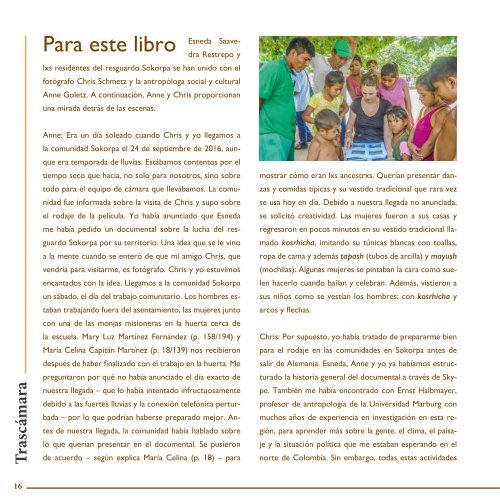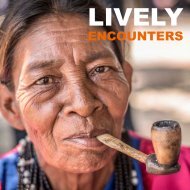‘Nanarh Yukpapi’ - somos yukpa | we are yukpa
‘Nanarh Yukpapi’ representa un paso firme de lxs Sokorpa-Yukpa hacia el público. Quieren que el mundo sepa sobre su existencia, su forma de vida y la lucha incansable por su territorio en el noreste de Colombia. Para este libro de fotos, lxs líderes y residentes del resguardo Sokorpa se han unido con un fotógrafo y una antropóloga social y cultural. Fotos únicas e historias individuales proporcionan un acercamiento personal hacia las personas fotografiadas. Textos adicionales informan sobre las condiciones locales y el contexto sociopolítico. ‘Nanarh Yukpapi’ represents the Sokorpa-Yukpa’s confident step into the public domain. They want the world to know about their existence, their way of life and their tireless struggle for their territory in Northeastern Colombia. For this photo book, the leaders and inhabitants of the Sokorpa territorial unit have teamed up with a photographer and a social and cultural anthropologist. Unique photos and individual stories allow for a personal approach to the photographees. Additional texts provide information about local living conditions and the socio-political context.
‘Nanarh Yukpapi’ representa un paso firme de lxs
Sokorpa-Yukpa hacia el público. Quieren que el
mundo sepa sobre su existencia, su forma de vida y
la lucha incansable por su territorio en el noreste de
Colombia. Para este libro de fotos, lxs líderes y residentes
del resguardo Sokorpa se han unido con un
fotógrafo y una antropóloga social y cultural. Fotos
únicas e historias individuales proporcionan un acercamiento
personal hacia las personas fotografiadas.
Textos adicionales informan sobre las condiciones
locales y el contexto sociopolítico.
‘Nanarh Yukpapi’ represents the Sokorpa-Yukpa’s
confident step into the public domain. They want
the world to know about their existence, their way
of life and their tireless struggle for their territory
in Northeastern Colombia. For this photo book,
the leaders and inhabitants of the Sokorpa territorial
unit have teamed up with a photographer and a
social and cultural anthropologist. Unique photos
and individual stories allow for a personal approach
to the photographees. Additional texts provide
information about local living conditions and the
socio-political context.
Create successful ePaper yourself
Turn your PDF publications into a flip-book with our unique Google optimized e-Paper software.
Para este libro<br />
Esneda Saavedra<br />
Restrepo y<br />
lxs residentes del resguardo Sokorpa se han unido con el<br />
fotógrafo Chris Schmetz y la antropóloga social y cultural<br />
Anne Goletz. A continuación, Anne y Chris proporcionan<br />
una mirada detrás de las escenas.<br />
Anne: Era un día soleado cuando Chris y yo llegamos a<br />
la comunidad Sokorpa el 24 de septiembre de 2016, aunque<br />
era temporada de lluvias. Estábamos contentos por el<br />
For this book<br />
Esneda Saavedra<br />
Restrepo and the<br />
inhabitants of the Sokorpa resguardo have teamed up with<br />
the photographer Chris Schmetz and the social and cultural<br />
anthropologist Anne Goletz. In the following, Anne and<br />
Chris provide a look behind the scenes.<br />
Anne: Chris and I arrived in the Sokorpa community on<br />
September 24th 2016: a sunny day, despite it being rainy<br />
season. We <strong>we</strong>re happy about the dry ride, not just for<br />
The women <strong>we</strong>nt to their houses and returned within<br />
minutes in their traditional outfit called kosrhicha, white<br />
robes, which they imitated with to<strong>we</strong>ls, bed linen and further<br />
white textiles, and tapash (clay pipes) and mayush<br />
(bags). Some women painted their faces, as they commonly<br />
do when dancing and celebrating. They dressed their<br />
sons with the male variant of kosrhicha and equipped them<br />
with bows and arrows.<br />
Chris: Of course, I had tried to prep<strong>are</strong> myself for the<br />
Behind the scenes<br />
tiempo seco que hacia, no solo para nosotros, sino sobre<br />
mostrar cómo eran lxs ancestrxs. Querían presentar dan-<br />
ourselves but especially for the camera equipment <strong>we</strong> had<br />
shooting in the Sokorpa communities as best as I could<br />
todo para el equipo de cámara que llevábamos. La comu-<br />
zas y comidas típicas y su vestido tradicional que rara vez<br />
with us. The community knew about Chris’ visit and the<br />
before leaving Germany. Esneda, Anne and I already had<br />
nidad fue informada sobre la visita de Chris y supo sobre<br />
se usa hoy en día. Debido a nuestra llegada no anunciada,<br />
planned movie shooting. I had announced that Esneda had<br />
structured the general storyline for the documentary via<br />
el rodaje de la película. Yo había anunciado que Esneda<br />
se solicitó creatividad. Las mujeres fueron a sus casas y<br />
asked me for a documentary about the Sokorpa’s struggle<br />
Skype. I also met with Ernst Halbmayer, professor of Social<br />
me había pedido un documental sobre la lucha del res-<br />
regresaron en pocos minutos en su vestido tradicional lla-<br />
for their territory. This was an idea she had had when she<br />
and Cultural Anthropology at the University of Marburg<br />
guardo Sokorpa por su territorio. Una idea que se le vino<br />
mado kosrhicha, imitando su túnicas blancas con toallas,<br />
heard that my friend who wanted to come visit was a pho-<br />
with extensive fieldwork experience in the region, to learn<br />
a la mente cuando se enteró de que mi amigo Chris, que<br />
ropa de cama y además tapash (tubos de arcilla) y mayush<br />
tographer. Chris and I <strong>we</strong>re pleased about the idea. We<br />
more about people, climate, landscape and the political sit-<br />
vendría para visitarme, es fotógrafo. Chris y yo estuvimos<br />
(mochilas). Algunas mujeres se pintaban la cara como sue-<br />
arrived at the Sokorpa community on a Saturday, the day<br />
uation that would await me in the northern part of Co-<br />
encantados con la idea. Llegamos a la comunidad Sokorpa<br />
len hacerlo cuando bailan y celebran. Además, vistieron a<br />
of community work. The men <strong>we</strong>re working outside of the<br />
lombia. Ho<strong>we</strong>ver, all these activities did not prep<strong>are</strong> me<br />
un sábado, el día del trabajo comunitario. Los hombres es-<br />
sus niños como se vestían los hombres: con kosrhicha y<br />
settlement, the women together with one of the mission-<br />
for what was really waiting for me: a group of people who<br />
taban trabajando fuera del asentamiento, las mujeres junto<br />
arcos y flechas.<br />
ary nuns in the vegetable garden near the school. Having<br />
<strong>we</strong>lcomed me very warmly, in spite of the fact that I spoke<br />
con una de las monjas misioneras en la huerta cerca de<br />
finished the gardening, Mary Luz Martínez Fernández (p.<br />
only some Spanish and no Yukpa at all. Soon <strong>we</strong> <strong>we</strong>re<br />
la escuela. Mary Luz Martínez Fernández (p. 158/194) y<br />
Chris: Por supuesto, yo había tratado de prepararme bien<br />
18/139) and María Celina Capitán Martínez (p. 18/139) <strong>we</strong>l-<br />
laughing about the heavy, tall guy (me!) who made his mule<br />
María Celina Capitán Martínez (p. 18/139) nos recibieron<br />
para el rodaje en las comunidades en Sokorpa antes de<br />
comed us. They asked me why I hadn’t announced our ex-<br />
después de haber finalizado con el trabajo en la huerta. Me<br />
salir de Alemania. Esneda, Anne y yo ya habíamos estruc-<br />
act arrival day – which in fact I had tried but failed to do, due<br />
preguntaron por qué no había anunciado el día exacto de<br />
turado la historia general del documental a través de Sky-<br />
to heavy rainfalls and the disturbed telephone connection<br />
Trascámara<br />
nuestra llegada – que lo había intentado infructuosamente<br />
debido a las fuertes lluvias y la conexión telefónica perturbada<br />
– por lo que podrían haberse preparado mejor. Antes<br />
de nuestra llegada, la comunidad había hablado sobre<br />
lo que querían presentar en el documental. Se pusieron<br />
de acuerdo – según explica María Celina (p. 18) – para<br />
pe. También me había encontrado con Ernst Halbmayer,<br />
profesor de antropología de la Universidad Marburg con<br />
muchos años de experiencia en investigación en esta región,<br />
para aprender más sobre la gente, el clima, el paisaje<br />
y la situación política que me estaban esperando en el<br />
norte de Colombia. Sin embargo, todas estas actividades<br />
– so they could have prep<strong>are</strong>d better. They had discussed<br />
on what to present in the documentary. As María Celina<br />
Capitán Martínez (p.18) explains, they had agreed to show<br />
what the ancestors <strong>we</strong>re like and to present their dances,<br />
food and traditional outfits that <strong>are</strong> r<strong>are</strong>ly used today.<br />
Due to our unannounced arrival, creativity was called for.<br />
16 17



